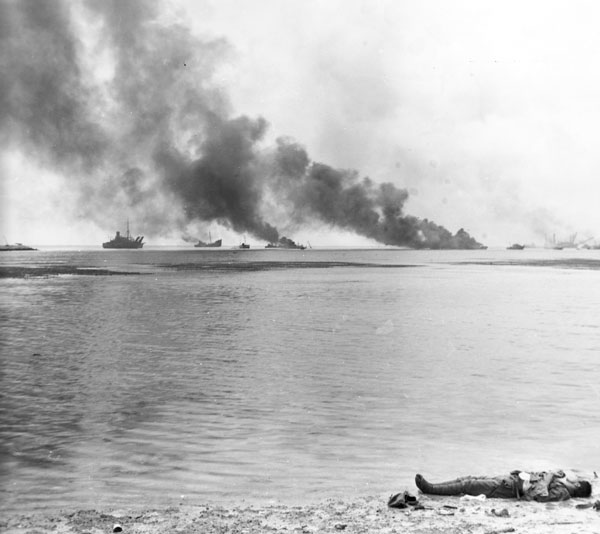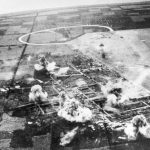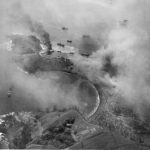A nightmare from hell
This afternoon, 76 years ago, Rear Adm. Marc Mitscher, commander of Fast Carrier Task Force 58, initiated the campaign to capture Saipan, Tinian and Guam: Operation Forager. The attack had been scheduled for early on the morning of June 12, 1944, but when a search plane from Tinian’s Hagoi airfield spotted the fleet some 200 miles east of Saipan and Tinian, Mitscher urged Adm. Nimitz to allow him to begin operations immediately. With permission granted, Mitscher began launching aircraft for attacks on Pagan, Saipan, Tinian, Rota and Guam. The horror of war began.
This was not Mitscher’s first visit to the Marianas. He had conducted the initial raid against Saipan, Tinian and Guam on Feb. 22-23, when Adm. Spruance, commander, 5th Fleet, sent him to check out the status of Japanese defenses. Then, in mid-April, Adm. Nimitz requested support from the 7th Air Force in Guadalcanal and Eniwetok to have their long-range B-24 Liberators conduct a photo-reconnaissance missions in the Marianas for planning purposes. The last of the recon missions was flown on June 1, giving Spruance’s planners up-to-date photos they could study aboard ship while cruising from Majuro in the Marshall Islands to the Marianas.
Mitscher’s mission this time was to establish air superiority over the Mariana Islands before Adm. Spruance arrived with the battle fleet. The 15 aircraft carriers in the fast carrier fleet were divided into four task forces, each with individually assigned targets on islands as far north as Chichi Jima, to Iwo Jima, and south to Pohnpei, Palau and Truk to prevent their interference with the invasion. The civilians in the Marianas were accustomed to the sights and sounds of Japanese aircraft operating from Japanese airfields at As Lito on Saipan, Hagoi on Tinian, Sinapalo on Rota, and Orote in Guam. But they were surprised when hundreds of American F6F Hellcats came screaming in from the east shortly after lunch, targeting airfields and shooting down Japanese aircraft that took to the air. Many civilians would have immediately remembered the terror of the February raid, grabbing their children and elderly and making a dash for hideouts they had prepared during the ensuing three months. Those who had not established a refuge had no place to hide, dodging bombs and bullets as they scrambled helter-skelter for their lives.
The first locals to face the wrath of Mitscher’s naval aviators were those working at the airfields, fueling and arming Japanese fighter aircraft. Although the American pilots were well aware of the large civilian populations on Saipan, Tinian, Rota and Guam, their bullets were impartial as they bombed and strafed the airfields. Japanese military personnel, including Okinawan-Japanese Imperial Army and Navy soldiers and sailors, as well as Korean, Chamorro and Carolinian workers, tasted American steel and died.
Next came port facilities at Tanapag Harbor, Saipan; Sanhalom Bay, Tinian; and San Luis de Apra, Guam. Ships at anchor were easy targets for the well-trained American torpedo bombers. After airfield and port facilities, Mitscher’s flyboys attacked communication centers, knocking down radio antennae and cutting communications with Tokyo. However, Gen. Saito, commander of all Japanese Imperial Army Forces on Saipan, and Adm. Nagumo, commander of all Japanese Imperial Navy forces on Saipan, had already sent messages to their respective commanders, who had then ordered Adm. Ozawa, commander of the Japanese 1st Mobile Fleet anchored in Tawi-Tawi, southern Philippines, to make ready to meet the American navy in the Marianas, if in fact this was the prelude to an invasion.
Finally, Mitscher’s Hellcats hit the sugar refineries at Chalan Kanoa, Sanhalom Bay, and Sasanhaya Bay and their railroad terminals. Roads were potholed, stopping all ground transportation. Pilots who had ammunition remaining were authorized to hit “targets of opportunity.” Their machine guns strafed Garapan, Chalan Kanoa, Tinian Town, Tatachog, Sinapalo, Agat, Sumay, and Piti.
As the sun set and the American aircraft returned to their ships, civilians and Japanese military personnel alike prayed that June 11 was only a repeat of the February raid. They recognized the grim face of reality when the Hellcats returned at dawn on June 12. Once again, the Hellcats searched out Japanese aircraft, on the ground and in the air. By noon they ran out of targets. Air superiority had been established.
A convoy of twelve ‘Marus’ in Tanapag Harbor had skedaddled for their home ports on the evening of June 11, but were caught by Adm. Harrill’s task group 58.4 on the 12th some 160 miles NNW of Saipan and destroyed, along with a torpedo boat and three subchasers. They were also responsible for catching the naval auxiliary Bokuyo Maru (2,726 tons) and beaching the Keiyo Maru (6,441 tons) at Tanapag. Adm. Nimitz’s submarine net set around the Marianas were prepared for any Japanese ships that might try to reinforce the Marianas.
Much to Gen. Saito’s dismay, America’s new battlefleet, constructed in American shipyards in the two and one-half years since Pearl Harbor, arrived in the Marianas on the 12th. From the target maps that had been created at Pearl Harbor and refined aboard ship during the cruise to the Marianas, the systematic bombardment of Japanese defensive positions began. The young, untested crews of the new ships were not accurate. But when thousands of shells exploded all along the western shorelines of Saipan, Tinian and Guam, many civilians and military personnel were killed or wounded.
Then came the V Amphibious Corps. The 2nd and 4th Marine Divisions and the 27th Army Infantry Division arrived off Saipan and the 3rd Marine Division and the 1st Provisional Marine Brigade off Guam—127,000 troops in all, in the afternoon of the 12th. They were held well offshore, out of harm’s way, for the time being. There was no doubt now, in anyone’s mind, that the invasion of the Marianas was close at hand. Those civilians who had foreseen this day and made the effort to stash food, medicine and clothing in caves or rancheros would survive the days, weeks and years ahead much better than those who had not. Ultimately however, the amphibious invasion of the Marianas would be a nightmare from hell that all Chamorros and Carolinians in Marianas who survived the war would remember the rest of their lives, whether they wanted to or not.
- Archive photo shows the Hagoi Airfield on Tinian.
- Archive photo shows the Pagan strike.


























